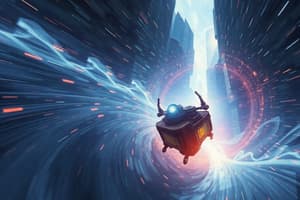Podcast
Questions and Answers
Which of the following scenarios best illustrates a non-contact force?
Which of the following scenarios best illustrates a non-contact force?
- A hockey puck slowing down as it slides across the ice.
- An apple falling from a tree. (correct)
- A car's tires rolling on a road.
- A carpenter hammering a nail into a piece of wood.
A book rests on a table. Which force directly opposes the gravitational force acting on the book?
A book rests on a table. Which force directly opposes the gravitational force acting on the book?
- The sliding friction force.
- The applied force.
- The normal force. (correct)
- The magnetic force.
A box is being pushed across a floor at a constant speed. What can be concluded about the forces acting on the box?
A box is being pushed across a floor at a constant speed. What can be concluded about the forces acting on the box?
- The force applied is less than the force of friction.
- There is no friction acting on the box.
- The force applied is greater than the force of friction.
- The force applied is equal to the force of friction. (correct)
In which scenario would static friction be most beneficial?
In which scenario would static friction be most beneficial?
How does increasing the distance between two objects affect the gravitational force between them?
How does increasing the distance between two objects affect the gravitational force between them?
An astronaut has a weight of 539N and a mass of 55kg on Earth. If the astronaut travels to the moon, which of these values would change?
An astronaut has a weight of 539N and a mass of 55kg on Earth. If the astronaut travels to the moon, which of these values would change?
Which of the following is an example of fluid friction?
Which of the following is an example of fluid friction?
If two objects have equal mass, but object A is twice the distance from earth as object B, which object experiences greater gravitational force?
If two objects have equal mass, but object A is twice the distance from earth as object B, which object experiences greater gravitational force?
Flashcards
Force
Force
A force; a push or pull on an object, measured in newtons (N).
Contact Force
Contact Force
A push or pull on one object by another that is touching it.
Non-contact Force
Non-contact Force
A push or a pull on one object by another without them touching.
Friction
Friction
Signup and view all the flashcards
Static Friction
Static Friction
Signup and view all the flashcards
Sliding Friction
Sliding Friction
Signup and view all the flashcards
Fluid Friction
Fluid Friction
Signup and view all the flashcards
Gravity
Gravity
Signup and view all the flashcards
Study Notes
- Forces described in terms of gravity, friction, electric and magnetic forces.
- Gravity and friction are discussed in Chapter 2.
- Electric forces are discussed in Chapter 19.
- Magnetic forces are discussed in Chapter 20.
The BIG Idea
- Forces change the motion of an object.
Lesson 1: Gravity and Friction
- Covered are some contact and non-contact forces
- The law of universal gravitation is covered.
- How friction affects the motion of two objects sliding past each other is discussed.
Types of Forces
- Force: A push or pull on an object, measured in newtons (N).
- Contact force: A push/pull on an object by another that is touching it (e.g., pushing a container, pressing computer keys, friction).
- Non-contact force: A push/pull on an object by another without touching it (e.g., gravity, magnetic, electrical).
Types of Friction
- Friction: A force that resists the motion of two objects that are touching.
- Static Friction: Prevents objects from sliding past each other.
- Sliding Friction: Opposes the motion of objects sliding past each other.
- Fluid Friction: Friction between a surface and a fluid such as water/air (air resistance).
Static Friction vs. Sliding Friction
- Static Friction diagram: Static friction is -100N, Applied force is 100N, Net Force = 0N.
- Sliding Friction diagram: Sliding friction is -70N, Applied force is 200N, Net Force = 130N.
Gravity
- Gravity: An attractive force between all objects with mass.
- Mass: Amount of matter in an object.
- Change in mass: Gravitational pull increases with mass.
- Change in distance: Gravitational pull lessens with distance.
Weight vs. Mass
- Weight: If an astronaut weighs 539N and has a mass of 55kg on Earth, what variable would change if she was on the moon? (F=ma).
- On the moon, an astronaut's weight would be less, but their mass would not change unless they got thinner or fatter.
Electrical Force
- Static Charge: Unbalanced positive or negative charge on an object.
- Opposite charges attract.
- Like charges repel.
- Electric charge variables:
- The more charge, the greater the electrical force (attraction or repulsion).
- The more distance, the less electrical force.
Magnetic Force
- Magnet: Object that attracts iron metal.
- Magnetic Pole: Place on a magnet where the force it applies is the strongest.
- Opposite poles attract each other.
- Like poles repel each other.
- Magnetic strength variables:
- Size of magnet.
- The further away magnets are, the weaker the magnetic force.
Studying That Suits You
Use AI to generate personalized quizzes and flashcards to suit your learning preferences.
Related Documents
Description
Explore the fundamental forces that govern the motion of objects: gravity, friction, electric, and magnetic forces are covered. Contact and non-contact forces are discussed, with a focus on gravity, friction, electric, and magnetic forces. Emphasis on the law of universal gravitation and the effects of friction.




